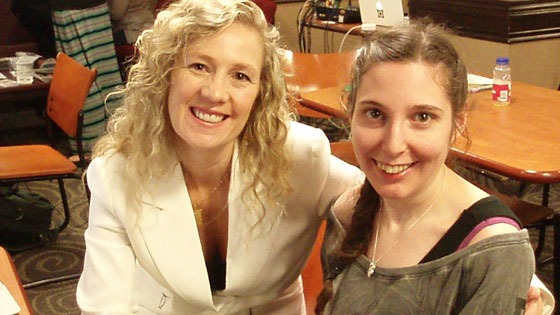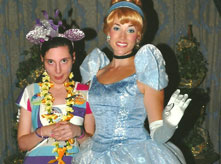
Dr. Danielle Andrade, neurologist and director of the Epilepsy Genetics Program, shares a moment with her patient, Daniela Clozza. (Photo: Clozza family)
It's not surprising that the Clozza family experienced a magical moment on a recent trip to Disney World. But the reason went beyond daughter Daniela meeting an enchanted princess or two.
"It was very special for us because it was the first time we were able to travel as a family," said Guida Clozza, Daniela's mother. "I never thought we would be able to do something like this."
Daniela has suffered from intractable seizures since infancy. She suffered her first seizure at three months of age and was diagnosed with epilepsy shortly after having many subsequent seizures.
But medical experts couldn't tell her parents much more about the type of epilepsy she had or give them a reason for how she came to develop her seizure disorder.
Seizures came in clusters
Managing Daniela's epilepsy was challenging. Her seizures came in clusters and she sometimes had five or more violent seizures per night.
These seizures, called tonic clonic seizures (formerly k known as a grand mal seizure), feature a loss of consciousness and violent muscle contractions. When the seizures struck, Daniela's mom would sleep with her to help her through the night.
Daniela was prescribed a variety of different medications in an attempt to manage the seizures, but the drugs left her lethargic and groggy. As a result, the fatigue caused her to miss days of school – and days of life.
"We did our best to find a balance of medications that worked," said Guida. "But the treatment was really having a negative effect on her quality of life."
A fateful meeting
In 2010, Daniela turned 18, which meant an automatic transition from the pediatric epilepsy program she'd been in since she was born to one for adults. The transition was particularly meaningful as it led her to meet Dr. Danielle Andrade, neurologist at the Krembil Neuroscience Centre of Toronto Western Hospital, and Director of the Epilepsy Genetics Program.
 Dream come true:
Dream come true: After receiving proper diagnosis and medication to manage her genetically-determined epilepsy disorder, Daniela Clozza realized her dream of celebrating her 21st birthday at Disney World. (Photo: Clozza family)
Founded by Andrade in 2010, the program seeks to better understand genetically-determined epilepsy.
Information captured through genetic testing of patients and families not only helps patients better understand their diagnosis, but also helps researchers find new genes associated with epilepsy and look for clues on how to treat them.
Finding genes for epilepsies that are difficult to treat can lead to the development of new drugs specific to their genetic pathways that are more effective and have fewer side effects.
Importance of genetic diagnosis
"In some cases the genetic diagnosis will lead to a change in the medical treatment and a better seizure control as a result," said Andrade.
"Recently, there has been major progress with genetic discoveries related to epilepsy," she continued. "Even if a patient was completely investigated when they were two years old, technology has changed so much that another investigation when that patient is older could lead to a more precise and different diagnosis."
Andrade's assessment of Daniela's symptoms led her to suspect that she had a genetic type of epilepsy. Sure enough, follow-up blood work confirmed that Daniela had Dravet syndrome (Dravet) which had previously gone undetected.
Rare, severe form
Dravet, also known as Severe Myoclonic Epilepsy of Infancy (SMEI), is a rare form of severe and intractable epilepsy that begins in infancy. These patients are at higher risk of death – called SUDEP - sudden unexplained death in epilepsy - and often have other associated conditions such as behavioural and developmental delays. Children with Dravet do not outgrow this condition.
Although Daniela's condition is by no means solved, the proper diagnosis helped give the Clozza family focus.
Not only do they now know which drugs to avoid, but Dravet also has a relatively effective drug treatment that has helped better manage Daniela's seizures.
Guida also cofounded
Dravet.ca, a Canadian network for families, friends, and caregivers of people living with Dravet Spectrum Disorders.
With Daniela responding well to her medication, the Clozzas were finally able to embark on that long dreamed about vacation.
"I really felt someone was watching out for us after we met Dr. Andrade," said Guida. "After getting the proper diagnosis and medication, I felt confident that we could test the waters and go on this trip. It was such a dream come true to have Daniela celebrate her 21st birthday at Disney World. She is by no means seizure free, but her condition feels much more manageable now."
Gene testing defines diagnosis
"You still mourn the diagnosis, but it's important for these patients to have hope." –Daniela's mom, Guida Clozza
In the last five years alone, approximately 300 genes related to epilepsy have been discovered.
Once a gene is identified, researchers must learn its pathway – how it interacts with other groups of genes. Understanding the pathway can help identify medications to correct its malfunctioning areas – which often cause seizures – and improve the interactions.
Or, as in Helen Leask's case, genetic screening for epilepsy can provide a better understanding of what one's child is suffering from.
'Progression of disasters'
Helen's daughter, Martha, also suffered from seizures at an early age, but doctors could only say she had a complex form of epilepsy that was taking a course that differed from known types of the disorder.
"I can only describe it as a progression of disasters. Martha went from having cognitive delay, to having seizures, then she started having behavioural problems, and eventually psychosis," said Helen. "My daughter was disappearing before my eyes."
The combination and evolution of Martha's symptoms was a mystery to health experts and Helen was at a loss to explain to care workers and school staff what was affecting her daughter. Because of all the symptoms, some even began to question whether Helen was managing Martha's epilepsy effectively.
Key question
Helen and her family coped as best they could and, in 2010 when she turned 18, Martha also transitioned to Andrade's care. But rather than focus on the number of seizures Martha was having, Andrade asked Helen one critical question: "Is your daughter getting worse?"
Since the answer was an absolute "yes," Andrade screened Martha for any genes that might be responsible for this complex type of epilepsy. It took a few months and involved screening other family members, but they finally had an answer: Martha had PCDH19-gene-related epilepsy – a condition with a wide spectrum of severity in seizures, cognitive delays and other symptoms caused by a gene mutation that is only expressed in girls.
"Finally knowing Martha had an identifiable syndrome, recognized by medical studies, was an enormous help," said Helen. "It doesn't, of course, change the fact that she has epilepsy which can be devastating to deal with, but discovering she had a rare gene disorder that explained all her symptoms was a huge relief."
Diagnosis in hand, Helen no longer needed to give others long, detailed explanations about all the aspects of Martha's condition, and finally having a name for it was a big factor in securing government support to assist with Martha's care.
Managing epilepsy while living full lives
Although still living with the daily challenges of having severe epilepsy syndromes, both Daniela and Martha are transitioning to become more independent and leading full, busy lives. Daniela just graduated from school and has a work placement at a community library. Martha now lives independently with a full-time support worker, plays sports with Special Olympics, works part-time and
sells her art through her own website.
Daniela's mother, Guida, has hope for these patients now that there is more awareness, understanding and better screening for Dravet and other genetic types of epilepsy.
"You still mourn the diagnosis," she said. "But it's important for these patients to have hope, and I think Daniela and others who are managing the condition on a daily basis are good examples of that."
Related Links
